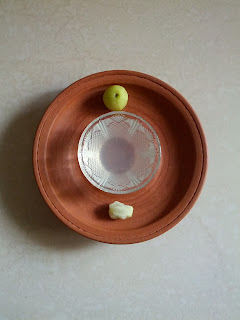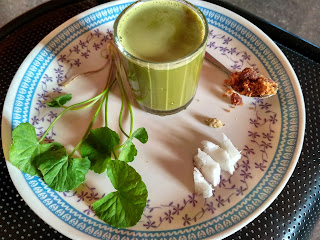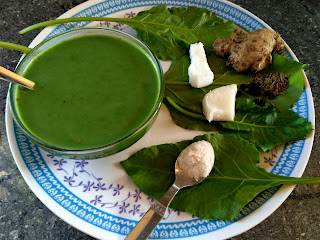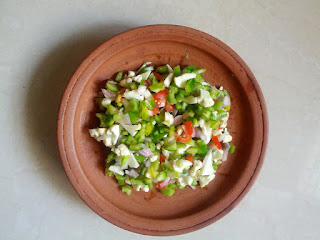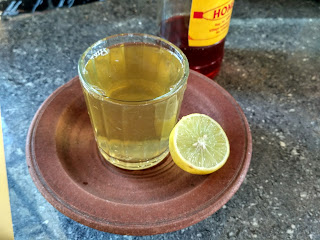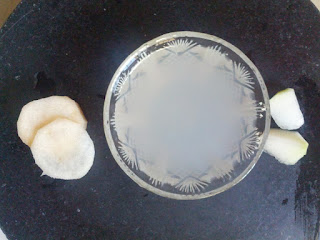இயற்கை வாழ்வியல் என்பது இயற்கை மருத்துவச் செம்மல் திரு. பாலகிருஷ்ணன் அவர்களால் ஏழு நாட்கள் நடத்தப்படும் பணிமனையாகும். மனிதர்கள் எந்த விதமான நோய்களும் மருந்துகளும் இன்றி இயற்கை முறையில் ஆரோக்கியமான வாழ்க்கை வாழக் கற்றுக் கொடுப்பதே இப்பணிமனையின் நோக்கமாகும். இறைவனின் (இயற்கையின்) அருளால் இந்நிகழ்வில் பங்கு கொள்ள முடிந்தது. நாங்கள் இந்த பயிற்சியில் கற்றுக் கொண்ட, அன்றாட வாழ்வில் கடைபிடிக்கும் நெறிமுறைகளை இவ்வலைப்பூ மூலம் பகிர்ந்து கொள்ளவிருக்கிறோம்.
இயற்கை வாழ்வியல் என்றால் என்ன என்பது குறித்து விரிவாக பார்க்கும் முன்னர், ஆரோக்கியமான உணவு மற்றும் உடல் நலம் பற்றிய எங்கள் கேள்விகளையும், தேடல்களையும் பற்றி குறிப்பிட்டாக வேண்டும். ஏனெனில் இங்கு பகிர்ந்து கொள்ளப்படும் தகவல்கள், எங்களைப் போலவே ஆரோக்கியமான வாழ்க்கை பற்றிய தேடல் உள்ளவர்களுக்கு நிச்சயம் பயனுள்ளதாக இருக்கும்.
திருமணத்திற்கு பிறகு, நமக்குத் தேவையான சத்தான உணவை நமது வீட்டிலேயே சமைத்து உண்ணலாம் என்றும் அதன் மூலம் நல்ல உடல் நலத்துடன் வாழலாம் என்றும் நினைத்திருந்தோம். அதன் படியே சத்துக்கள் நிறைந்ததாக நம் மருத்துவர்கள் மற்றும் நம் அனைவராலும் ஏற்றுக் கொள்ளப்பட்டுள்ள உணவு வகைகளான பால் (அதில் கலந்து குடிக்கும் கலவை), முட்டை, அதிகமான பழ வகைகள், காய்கறிகள் போன்றவற்றை சாப்பிட்டும் வந்தோம். இருந்தாலும் எங்கள் இருவருக்கும் கடந்த சில ஆண்டுகளாக உடல் நலக்குறைபாடு என்பது ஒரு தொடர்கதையாகவே இருந்தது. ஒவ்வொரு சனிக்கிழமையும் ஒரு மருத்துவ நிபுணரை சந்திப்பதும் மாத்திரைகளை வாங்கி சாப்பிடுவதும் தொடர் நிகழ்வானது.
இந்நிலையில் எனக்கு இருந்த உடல் உபாதைக்காக சிறிய அறுவை சிகிச்சை செய்து கொண்டேன். ஆனால் அறுவை சிகிச்சைக்கு பிறகும் பிரச்சினையில் எந்த மாற்றமும் இல்லை. ஒரு காலகட்டத்தில் இதன் காரணமாக என்னுடைய வேலையையும் துறந்தேன். வீட்டில் இருந்து உடல் நலத்தை முழுமையாக கவனித்துக் கொள்ள முடியும் என்று நினைத்தேன். உடற்பயிற்சி மையத்தில் சேர்ந்து சில மாதங்கள் பயிற்சி செய்து வந்தேன். ஆங்கில மருத்துவத்திற்கு மாற்றாக இருவரும் ஹோமியோபதி முறைக்கு மாறினோம். ஆனாலும் வேறு சில உடல் உபாதைகள் அதிகரிக்கத் தொடங்கியதால் பயிற்சி மையத்திற்கும் செல்ல முடியாமல் போனது.
கடந்த சில ஆண்டுகளாக நாங்கள் எதிர்கொண்ட அனுபவங்கள், எங்கள் மனதில் கீழ்க்கண்ட வினாக்களை எழுப்பியது.
- ஊட்டச்சத்து நிரம்பிய உணவு என்பது எது?
- நாம் ஊட்டச்சத்து மிக்க உணவையே உட்கொண்டாலும் ஏன் நோய்வாய்ப்படுகிறோம்?
- உணவு பொருட்களுக்கும் நாம் உண்ணும் முறைகளுக்கும் நோய்கள் ஏற்படுவதற்கும் தொடர்பு உள்ளதா?
- மருத்துவத் துறை அதி வேகமான / நவீன வளர்ச்சியைக் கண்டிருந்தாலும், ஏன் இன்னும் பல வியாதிகளை முற்றிலுமாக ஒழிக்க முடியவில்லை அல்லது உருவாகாமல் தடுக்க முடியவில்லை?
- ஏன் மென்மேலும் புதிய வியாதிகள் உருவாகின்றன?
- மனிதர்கள் நோயின்றி வாழ்வதற்கான சாத்தியமே இல்லையா?
இத்தகைய கேள்விகள் மனதில் எழுந்த போது அவற்றிற்கான பதில்களைத் தேட ஆரம்பித்தோம். அதில் மிக முக்கியமாக நாம் சந்தைகளில் / கடைகளில் வாங்கும் உணவுப் பொருட்கள் உண்மையிலேயே சத்துக்கள் நிரம்பியவைதானா என்று சிந்தித்துப் பார்த்ததில், இல்லை என்பதே பதிலாக இருந்தது. ஒவ்வொரு உணவுப் பொருளிலும் விளைவிப்பதில் துவங்கி நுகர்வோரான நம்மை வந்தடையும் வரை பல விதமான இரசாயனங்களின் சேர்க்கை தவிர்க்க இயலாத ஒன்றாக மாறி விட்டது. இந்த உண்மை நன்கு தெரிந்திருந்தாலும், நம்மால் மட்டும் இதற்கு வழி காண முடியாது என்று அனைவரையும் போலவே நாங்களும் அத்தகைய இரசாயனங்கள் கலந்த பொருட்களை வாங்கி வந்தோம்.
இந்த சூழ்நிலையில் கவிப்பேரரசு வைரமுத்து அவர்கள் ஆனந்த விகடன் இதழில் எழுதிய 'மூன்றாம் உலகப்போர்' என்ற தொடர்கதையை படிக்க நேர்ந்தது. அத்தொடர் உலக மயமாக்கல் காரணமாக சுற்றுப்புற சூழலில் ஏற்பட்டிருக்கும் கேடுகள், நம் நாட்டில் விளைநிலங்கள் மற்றும் சிறு, குறு விவசாயிகளின் வீழ்ச்சிக்கான காரணங்களை தெள்ளத்தெளிவாக விளக்கியது. இது நுகர்வோராக நம்மால் என்ன செய்ய முடியும் என்று கையைக் கட்டிக் கொண்டிருந்த எங்களை மிகவும் சிந்திக்க வைத்தது. இதன் காரணமாக நாங்கள் இயற்கை முறையில் விளைவிக்கப்பட்ட உணவு பொருட்களை மட்டுமே வாங்குவதென்று முடிவு செய்து அதை உடனடியாக செயல்படுத்தவும் தொடங்கினோம்.
மூன்றாம் உலகப்போர் தொடருக்குப் பின்னர், ஆனந்த விகடன் மீண்டும் ஒரு சிறந்த தொடரை வெளியிடத் துவங்கியது. அது சித்த மருத்துவர் கு.சிவராமன் அவர்கள் எழுதி வரும் 'ஆறாம் திணை' ஆகும். இத்தொடரானது நம் மூதாதையர்கள் பழங்காலத்திலிருந்து, கடந்த இரண்டு தலைமுறைக்கு முன்பு வரை உண்டு வந்த பாரம்பரிய அரிசி வகைகள் மற்றும் சிறுதானியங்களை அறிமுகப்படுத்தியது. அன்று முதல் பட்டை தீட்டப்பட்ட வெள்ளை அரிசியுடன் இடைஇடையே பாரம்பரிய அரிசி மற்றும் சிறுதானியங்களையும் சமையலில் பயன்படுத்த துவங்கினோம். சில மாதங்களில் உடல் நலத்திலும் சிறிய முன்னேற்றத்தை உணர முடிந்தது. இருப்பினும் முழுமையான ஆரோக்கியம் என்பது கிடைக்கவில்லை.
இந்த சூழ்நிலையில்தான், என் கணவரின் நண்பர் திரு.ஜெய் அவர்கள் மூலம் கோயம்பத்தூரில் நடைபெறவிருந்த இயற்கை வாழ்வியல் பயிற்சி முகாமில் கலந்து கொள்ளும் வாய்ப்பு கிடைத்தது. இத்தகைய அரிய சந்தர்ப்பத்தை அளித்ததற்காகவும், நாங்கள் அறிந்து கொண்ட ஆரோக்கிய வாழ்க்கைக்கான இரகசியத்தை உங்களிடம் பகிர்ந்து கொள்ள வாய்ப்பு கிடைத்தமைக்கும் அந்த நண்பருக்கு இவ்வலைப்பூ மூலம் நன்றியைத் தெரிவித்துக் கொள்கிறோம்.
இயற்கை வாழ்வியல் மனிதகுலத்திற்கு தரும் நன்மைகளை அறிந்து கொண்ட பிறகு, அதை ஒரு இரகசியம் என்று சொல்வது தான் சரியாக இருக்கும். ஏனெனில் விஞ்ஞானம் கண்டுபிடித்த ஊட்டச்சத்து மிக்க உணவு என்கின்ற ஒரு வார்த்தையை பின்பற்றி நாம் அனைவரும் தவறான உணவு பழக்கத்திற்கு மாறிவிட்டிருக்கிறோம். நமது வாழ்க்கை முறையும் விஞ்ஞான வளர்ச்சி அல்லது நாகரிகம் என்கின்ற பெயரில், இயற்கையிலிருந்து முற்றிலும் விலகி செயற்கையானதாக மாறிவிட்டது. நம்முடைய தவறான கருத்துக்களினாலும் அணுகுமுறைகளினாலும், நமது ஆரோக்கியத்திற்கு மட்டுமல்லாது இந்த பூமியில் வாழும் மற்ற உயிரினங்களுக்கும், ஏன் இந்த பூமிக்குமே அழிவை உண்டாக்கிக் கொண்டிருக்கிறோம்.
ஒரு பொருளை எந்த இடத்தில் தொலைத்தோமோ, அதை அந்த இடத்தில் தேடினால் மட்டும் தான் கண்டுபிடிக்க முடியும். அதுபோல நமது ஆரோக்கியத்தை பாரம்பரிய உணவு மற்றும் வாழ்வியல் முறைகளில் தொலைத்து விட்டு, அதற்கான தீர்வை நவீன விஞ்ஞானத்திடமும் / மருத்துவத்திடமும் தேடிக்கொண்டிருக்கிறோம்.தற்போதைய சூழ்நிலையில், நம்மில் பலருக்கும், எதைத் தொலைத்தோம் என்பது கூட தெரியாமல் போய்விட்டது. சில சமயம், அது தெரிந்திருந்தாலும், அதற்கான தீர்வைத் தேடுவதிலும் விருப்பம் இருப்பதில்லை. ஒருவேளை தீர்வு கிடைத்தாலும், அதற்கான வழிமுறைகளை செயல்படுத்துவதை விரும்புவதில்லை. கடந்த சில வருடங்களாக, மருத்துவம் என்கின்ற உயரிய சேவை ஒரு வியாபாரமாக மாறிவிட்டது என்பதை நாம் நன்றாகவே உணர்ந்துள்ளோம். ஒரு வியாபாரியின் முதன்மையான நோக்கம் எதுவாக இருக்கும் என்பது தெரிந்தும், நம் உயிர் குறித்த அறியாமையினால் வரும் பயத்தின் காரணமாக மீண்டும் மீண்டும் அதே மருத்துவ முறைகளை நாடுகிறோம்.
இயற்கை வாழ்வியல் நமது உடல், உயிர் மற்றும் மனம் ஆகிய மூன்றுக்கும் உள்ள தொடர்பை விளக்குகிறது. யார், எத்தகைய உணவை, எப்படி, எங்கே, எந்த சூழலில் உண்ண வேண்டும் என்று கற்றுத் தருகிறது. இவ்வுலகில் நோய் என்ற ஒன்று இல்லை என்றும், நம்மால் நோய்கள் என்று தற்போது குறிப்பிடப்படும் உடல் பருமன், மலச்சிக்கல், அஜீரணம், தைராய்டு, சர்க்கரை வியாதி, இரத்தக் கொதிப்பு, ஆஸ்துமா, புற்றுநோய், குழந்தைப் பேறின்மை, பெண்களுக்கு உண்டாகும் உடல் நலக் கோளாறுகள், குழந்தைப் பிறப்பின் போது உண்டாகும் பிரச்சினைகள் போன்றவற்றிற்கான காரணங்களையும் விளக்குகிறது. இத்தகைய பிரச்சினைகள் நமக்கு ஏற்படாமல் நல்வாழ்வு வாழவும், தற்போது இத்தகைய வியாதிகளினால் அவதிப்படுபவர்கள், அதிலிருந்து குணமடைய சரியான உணவு பழக்க வழக்கத்தையும், சூரிய ஒளி, நீர் மற்றும் மண் கொண்டு எளியமுறையில் நமக்கு நாமே செய்து கொள்ளக்கூடிய சிகிச்சை முறைகளையும் கற்றுத் தருகிறது. சுருக்கமாகச் சொல்வதெனில் நிலம், நீர், காற்று, நெருப்பு, ஆகாயம் எனும் ஐம்பூதங்களினால் ஆன நமது உடல், அதே இயற்கையுடன் ஒன்றி வாழும் வாழ்வியல் முறைகளைக் கற்றுத் தருகிறது.
இந்த பயிற்சி முகாம் முடிவுற்ற பொழுது, நாங்கள் அதுவரை தேடிக்கொண்டிருந்த அத்தனை வினாக்களுக்கும் விடை கிடைத்தது. குறிப்பாக இயற்கையில் விளைவிக்கப்பட்ட பொருட்களை உண்பதால் மட்டுமே உடல் நலம் கிடைத்து விடாது. உணவை எந்த முறையில் உட்கொள்ள வேண்டும் என்ற இரகசியத்தை அறிந்து கொண்டோம். பயிற்சி முகாம் துவங்கிய இரண்டாவது நாளிலேயே நாங்கள் மாத்திரை எடுத்துக் கொள்வதை நிறுத்தி விட்டோம். கடந்த மே மாதம் முதல் இன்று வரை, இயற்கை வாழ்வியலை தொடர்ந்து கடைபிடித்து வருவதன் மூலம் அந்நாள் வரை அச்சுறுத்தி வந்த அனைத்து விதமான நோய்களிலிருந்தும் விடுபட்டு ஆரோக்கியமாக வாழ்ந்து வருகிறோம். இப்போது எந்த மருத்துவரிடமும் செல்ல வேண்டிய அவசியமின்றி, எந்த விதமான மருந்துகளின் தேவையுமின்றி நலமாக வாழ முடிகிறது. இப்போது சனிக்கிழமை என்பது இயற்கை அங்காடிக்கு சென்று அங்குள்ள இயற்கை முறையில் விளைவிக்கப்பட்ட உணவுப்பொருட்களை வாங்கி மகிழ்வதற்கான நாளாக மாறிவிட்டது.
இயற்கை வாழ்வியல் பணிமனை என்பது வருடத்தில் ஒரு சில முறை மட்டுமே நடைபெறுவதால், விருப்பமுள்ள அனைவருக்கும், அதில் பங்கு கொள்ள வாய்ப்பு உடனே கிடைப்பதில்லை. ஆகையால் தான், எங்கள் குரு திரு. பாலகிருஷ்ணன் ஐயா அவர்களின் விருப்பதின் படி, இயற்கை வாழ்வியல் கருத்துக்கள் மக்கள் அனைவருக்கும் சென்றடைய வேண்டும் என்கின்ற எண்ணத்தோடு, இந்த வலைப்பதிவின் மூலம் நாங்கள் கற்றுணர்ந்த வாழ்க்கை முறையை, உங்களுடன் பகிர்ந்து கொள்கிறோம்.
'எல்லாரும் இன்புற் றிருக்க நினைப்பதுவே
அல்லாமல் வேறொன் றறியேன் பராபரமே.'
என்கின்ற தாயுமானவரின் பிரார்த்தனையை போல,உலக மக்கள் அனைவரும் இயற்கை வாழ்வியலை கடைபிடித்து முழுமையான உடல் மற்றும் மனநலத்துடன் இன்பமான வாழ்க்கை வாழ வேண்டும் என்பதே இறைவனிடம் எங்களுடைய வேண்டுதல் ஆகும்.



